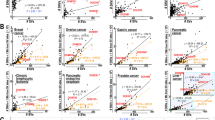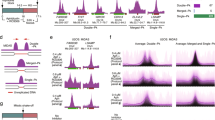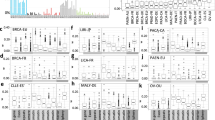Abstract
Common fragile sites (CFSs) are regions of the genome prone to breakage by replication inhibitors (extrinsic replication stress). Recently, we and others observed that oncogene-induced replication stress (RS) induces DNA damage from the earliest stages of cancer. Our aim was to perform a genome-wide analysis in precancerous and cancerous experimental models to examine whether allelic imbalance occurs within CFSs. Subsequently, CFSs sequence characteristics were assessed. We used a growth-factor-induced human skin hyperplasia and a H-ras-induced mouse hyperplastic urothelium as preneoplastic models, along with an inducible U2OS-CDT1Tet-ON cancer cell line model, all bearing established oncogene-induced RS stimuli. Human DNA was analysed with Affymetrix SNP microarrays, while mouse DNA was analysed with Nimblegen array CGH. We studied 56 aphidicolin-type CFSs and 1914 regions of control, nonfragile DNA. Our theoretical in silico analysis spanned 2.16 billion nonoverlapping bases on human chromosomes 1–22. Our results provide direct experimental evidence indicating that genomic alterations were more common within CFSs in epidermal and urothelial preneoplastic lesions as well as in cancer. CFSs were on average less flexible than nonfragile regions, contained more guanine–cytosine (GC) and Alu sequences. Importantly, regions with loss-of-heterozygosity were also less flexible and had a higher Alu percentage.
This is a preview of subscription content, access via your institution
Access options
Subscribe to this journal
Receive 50 print issues and online access
$259.00 per year
only $5.18 per issue
Buy this article
- Purchase on Springer Link
- Instant access to full article PDF
Prices may be subject to local taxes which are calculated during checkout






Similar content being viewed by others
Abbreviations
- AI:
-
allelic imbalance
- CFSs:
-
common fragile sites
- CGH:
-
comparative genomic hybridization
- FS:
-
fragile sites
- GF-hSHy:
-
growth-factor-induced human skin hyperplasia
- H-ras-mHyU:
-
H-ras-induced mouse hyperplastic urothelium
- RS:
-
replication stress
- SNP:
-
single nucleotide polymorphism
References
Aqeilan RI, Trapasso F, Hussain S, Costinean S, Marshall D, Pekarsky Y et al. (2007). Targeted deletion of Wwox reveals a tumor suppressor function. Proc Natl Acad Sci USA 104: 3949–3954.
Arlt MF, Durkin SG, Ragland RL, Glover TW . (2006). Common fragile sites as targets for chromosome rearrangements. DNA Repair (Amst) 5: 1126–1135.
Bartkova J, Hoesí Z, Koed K, Krämer A, Tort F, Zieger K et al. (2005). DNA damage response as a candidate anti-cancer barrier in early human tumorigenesis. Nature 434: 864–870.
Bartkova J, Rezaei N, Liontos M, Karakaidos P, Kletsas D, Issaeva N et al. (2006). Oncogene-induced senescence is part of the tumorigenesis barrier imposed by DNA damage checkpoints. Nature 444: 633–637.
Batzer MA, Deininger PL . (2002). Alu repeats and human genomic diversity. Nat Rev Genet 3: 370–379.
Berking C, Takemoto R, Satyamoorthy K, Shirakawa T, Eskandarpour M, Hansson J et al. (2004). Induction of melanoma phenotypes in human skin by growth factors and ultraviolet B. Cancer Res 64: 807–811.
Ciullo M, Debily MA, Rozier L, Autiero M, Billault A, Mayau V et al. (2002). Initiation of the breakage-fusion-bridge mechanism through common fragile site activation in human breast cancer cells: the model of PIP gene duplication from a break at FRA7I. Hum Mol Genet 11: 2887–2894.
DiMicco R, Fumagalli M, Cicalese A, Piccinin S, Gasparini P, Luise C et al. (2006). Oncogene-induced senescence is a DNA damage response triggered by DNA hyper-replication. Nature 444: 638–642.
Glover TW . (2006). Common fragile sites. Cancer Lett 232: 4–12.
Glover TW, Stein CK . (1988). Chromosome breakage and recombination at fragile sites. Am J Hum Genet 43: 265–273.
Gorgoulis VG, Vassiliou LVF, Karakaidos P, Zacharatos P, Kotsinas A, Liloglou T et al. (2005). Activation of the DNA damage checkpoint and genomic instability in human precancerous lesions. Nature 434: 907–913.
Hanahan D, Weinberg RA . (2000). The hallmarks of cancer. Cell 100: 57–70.
Helmrich A, Stout-Weider K, Hermann K, Schrock E, Heiden T . (2006). Common fragile sites are conserved features of human and mouse chromosomes and relate to large active genes. Genome Res 16: 1222–1230.
Helmrich A, Stout-Weider K, Matthaei A, Hermann K, Heiden T, Schrock E . (2007). Identification of the human/mouse syntenic common fragile site FRA7K/Fra12C1-Relation of FRA7K and other human common fragile sites on chromosome 7 to evolutionary breakpoints. Int J Cancer 120: 48–54.
Hirsch B . (1991). Sister chromatid exchanges are preferentially induced at expressed and nonexpressed common fragile sites. Hum Genet 87: 302–306.
Ihaka R, Gentleman R . (1996). R: a language for data analysis and graphics. J Comp Graph Stat 5: 299–314.
Lander ES, Linton LM, Birren B, Nusbaum C, Zody MC, Baldwin J et al. (2001). Initial sequencing and analysis of the human genome. Nature 409: 860–921.
Lengauer C, Kinzler KW, Vogelstein B . (1998). Genetic instabilities in human cancers. Nature 396: 643–649.
Mimori K, Druck T, Inoue H, Alder H, Berk L, Mori M et al. (1999). Cancer-specific chromosome alterations in the constitutive fragile region FRA3B. Proc Natl Acad Sci USA 96: 7456–7461.
Mishmar D, Mandel-Gutfreund Y, Margalit H, Rahat A, Kerem B . (1999). Common fragile sites: G-band characteristics within an R-band. Am J Hum Genet 64: 908–910.
Mishmar D, Rahat A, Scherer S, Nyakatura G, Hinzmann B, Kohwi Y et al. (1998). Molecular characterization of a common fragile site (FRA7H) on human chromosome 7 by the cloning of a simian virus 40 integration site. Proc Natl Acad Sci USA 95: 8141–8146.
Mo L, Zheng X, Huang HY, Shapiro E, Lepor H, Cordon-Cardo C et al. (2007). Hyperactivation of Ha-ras oncogene, but not Ink4a/Arf deficiency, triggers bladder tumorigenesis. J Clin Invest 117: 314–325.
Morelli C, Karayianni E, Magnanini C, Mungall AJ, Thorland E, Negrini M et al. (2002). Cloning and characterization of the common fragile site FRA6F harboring a replicative senescence gene and frequently deleted in human tumors. Oncogene 21: 7266–7276.
Murnane JP . (2006). Telomeres and chromosome instability. DNA Repair 5: 1082–1092.
Olshen AB, Venkatraman ES, Lucito R, Wigler M . (2004). Circular binary segmentation for the analysis of array-based DNA copy number data. Biostatistics 5: 557–572.
Olson WK, Gorin AA, Lu XJ, Hock LM, Zhurkin VB . (1998). DNA sequence-dependent deformability deduced from protein-DNA crystal complexes. Proc Natl Acad Sci USA 95: 11163–11168.
Packer MJ, Dauncey MP, Hunter CA . (2000). Sequence-dependent DNA structure: dinucleotide conformational maps. J Mol Biol 295: 71–83.
Sarai A, Mazur J, Nussinov R, Jernigan RL . (1989). Sequence dependence of DNA conformational flexibility. Biochemistry 28: 7842–7849.
Smith DI, McAvoy S, Zhu Y, Perez DS . (2007). Large common fragile site genes and cancer. Semin Cancer Biol 17: 31–41.
Toledo F, Coquelle A, Svetlova E, Debatisse M . (2000). Enhanced flexibility and aphidicolin-induced DNA breaks near mammalian replication origins: implications for replicon mapping and chromosome fragility. Nucleic Acids Res 28: 4805–4813.
Vaziri C, Saxena S, Jeon Y, Lee C, Murata K, Machida Y et al. (2003). A p53-dependent checkpoint pathway prevents rereplication. Mol Cell 11: 997–1008.
Wistuba II, Behrens C, Virmani AK, Mele G, Milchgrub S, Girard L et al. (2000). High resolution chromosome 3p allelotyping of human lung cancer and preneoplastic/preinvasive bronchial epithelium reveals multiple, discontinuous sites of 3p allele loss and three regions of frequent breakpoints. Cancer Res 60: 1949–1960.
Wu XR . (2005). Urothelial tumorigenesis: a tale of divergent pathways. Nat Rev Cancer 5: 713–725.
Zanesi N, Fidanza V, Fong LY, Mancini R, Druck T, Valtieri M et al. (2001). The tumor spectrum in FHIT-deficient mice. Proc Natl Acad Sci USA 98: 10250–10255.
Zlotorynski E, Rahat A, Skaug J, Ben-Porat N, Ozeri E, Hershberg R et al. (2003). Molecular basis for expression of common and rare fragile sites. Mol Cell Biol 23: 7143–7151.
Acknowledgements
We thank Professor Meenhard Herlyn for providing the human skin xenograft material. This work was co-funded by European Social Fund and National Resources-(EPEAEK-II) PYTHAGORAS II (SARG 7952) and National Kapodistrian University of Athens (SARG 56/90/6599, 70/4/9174).
Author information
Authors and Affiliations
Corresponding authors
Additional information
Conflicts of Interest
None.
Supplementary Information accompanies the paper on the Oncogene website (http://www.nature.com/onc).
Supplementary information
Rights and permissions
About this article
Cite this article
Tsantoulis, P., Kotsinas, A., Sfikakis, P. et al. Oncogene-induced replication stress preferentially targets common fragile sites in preneoplastic lesions. A genome-wide study. Oncogene 27, 3256–3264 (2008). https://doi.org/10.1038/sj.onc.1210989
Received:
Revised:
Accepted:
Published:
Issue Date:
DOI: https://doi.org/10.1038/sj.onc.1210989
Keywords
This article is cited by
-
Common fragile sites: protection and repair
Cell & Bioscience (2020)
-
High-resolution mapping of mitotic DNA synthesis regions and common fragile sites in the human genome through direct sequencing
Cell Research (2020)
-
3D genome organization contributes to genome instability at fragile sites
Nature Communications (2020)
-
Genome reorganization in different cancer types: detection of cancer specific breakpoint regions
Molecular Cytogenetics (2019)
-
Maintenance of the bladder cancer precursor urothelial hyperplasia requires FOXA1 and persistent expression of oncogenic HRAS
Scientific Reports (2019)



